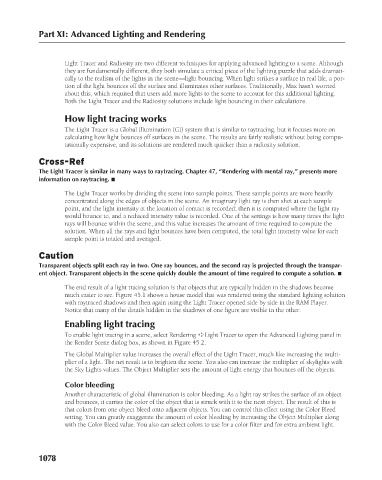Page 1126 - Kitab3DsMax
P. 1126
Part XI: Advanced Lighting and Rendering
Light Tracer and Radiosity are two different techniques for applying advanced lighting to a scene. Although
they are fundamentally different, they both simulate a critical piece of the lighting puzzle that adds dramati-
cally to the realism of the lights in the scene—light bouncing. When light strikes a surface in real life, a por-
tion of the light bounces off the surface and illuminates other surfaces. Traditionally, Max hasn’t worried
about this, which required that users add more lights to the scene to account for this additional lighting.
Both the Light Tracer and the Radiosity solutions include light bouncing in their calculations.
How light tracing works
The Light Tracer is a Global Illumination (GI) system that is similar to raytracing, but it focuses more on
calculating how light bounces off surfaces in the scene. The results are fairly realistic without being compu-
tationally expensive, and its solutions are rendered much quicker than a radiosity solution.
Cross-Ref
The Light Tracer is similar in many ways to raytracing. Chapter 47, “Rendering with mental ray,” presents more
information on raytracing. n
The Light Tracer works by dividing the scene into sample points. These sample points are more heavily
concentrated along the edges of objects in the scene. An imaginary light ray is then shot at each sample
point, and the light intensity at the location of contact is recorded; then it is computed where the light ray
would bounce to, and a reduced intensity value is recorded. One of the settings is how many times the light
rays will bounce within the scene, and this value increases the amount of time required to compute the
solution. When all the rays and light bounces have been computed, the total light intensity value for each
sample point is totaled and averaged.
Caution
Transparent objects split each ray in two. One ray bounces, and the second ray is projected through the transpar-
ent object. Transparent objects in the scene quickly double the amount of time required to compute a solution. n
The end result of a light tracing solution is that objects that are typically hidden in the shadows become
much easier to see. Figure 45.1 shows a house model that was rendered using the standard lighting solution
with raytraced shadows and then again using the Light Tracer opened side by side in the RAM Player.
Notice that many of the details hidden in the shadows of one figure are visible in the other.
Enabling light tracing
To enable light tracing in a scene, select Rendering ➪ Light Tracer to open the Advanced Lighting panel in
the Render Scene dialog box, as shown in Figure 45.2.
The Global Multiplier value increases the overall effect of the Light Tracer, much like increasing the multi-
plier of a light. The net result is to brighten the scene. You also can increase the multiplier of skylights with
the Sky Lights values. The Object Multiplier sets the amount of light energy that bounces off the objects.
Color bleeding
Another characteristic of global illumination is color bleeding. As a light ray strikes the surface of an object
and bounces, it carries the color of the object that is struck with it to the next object. The result of this is
that colors from one object bleed onto adjacent objects. You can control this effect using the Color Bleed
setting. You can greatly exaggerate the amount of color bleeding by increasing the Object Multiplier along
with the Color Bleed value. You also can select colors to use for a color filter and for extra ambient light.
1078

